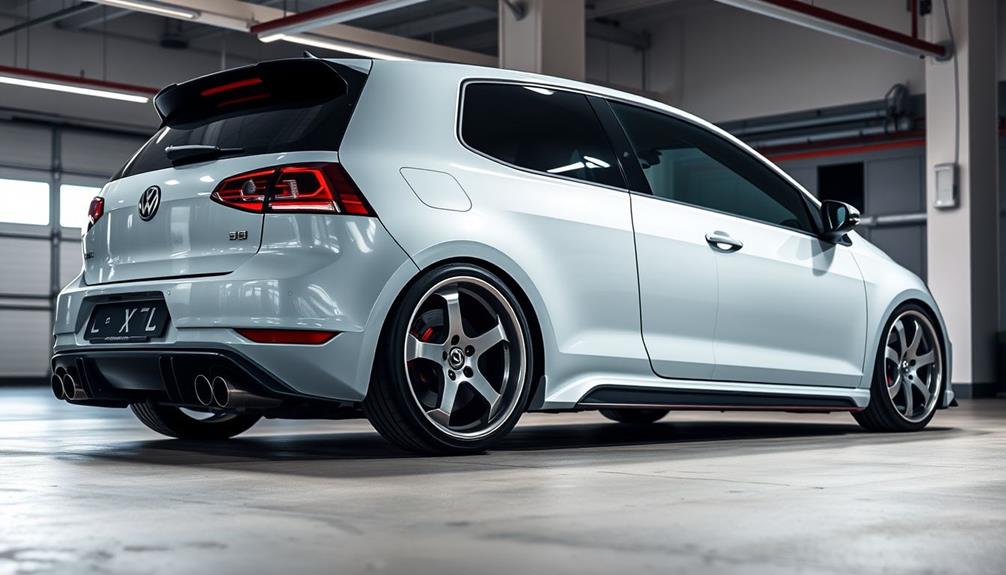Tuning your Volkswagen Jetta GLI 1.8 Turbo can greatly enhance its power and performance. You can achieve up to 55 additional horsepower simply through ECU tuning. Adding a performance cold air intake and an aftermarket exhaust will further increase power and improve throttle response. Don't forget about essential components like the N75 valve to manage boost effectively, yielding even more gains. Upgrading your suspension and brakes also guarantees that your sedan handles better with the added power. There's plenty more to explore, so stick around to uncover additional tuning tips and enhancements for your turbocharged sedan.
Key Takeaways
- ECU tuning can boost power by up to 55 hp and improve throttle response for a more dynamic driving experience.
- Installing a performance Cold Air Intake can increase horsepower by 20-30 when combined with an ECU tune.
- Upgrading to a bigger turbo, like the K04, enhances power while maintaining desirable spool characteristics.
- Improved suspension with coilovers and sway bars enhances handling and stability, maximizing the benefits of engine upgrades.
- Regular maintenance checks on critical components ensure optimal performance and prevent issues that could hinder power delivery.
Understanding Turbocharging Basics
Turbocharging revolutionizes engine performance by forcing more air into the combustion chamber, allowing for a more efficient burn of fuel and ultimately boosting horsepower.
When you look at vehicles like the Volkswagen Jetta GLI 1.8 Turbo, you'll see how turbocharging enhances efficiency compared to naturally aspirated engines. The turbocharger compresses intake air, enabling your engine to burn more fuel and generate greater power.
With proper tuning, a turbocharged engine can yield significant gains. For example, a mere 1 PSI increase in boost can add about 10 horsepower at the crank, giving you a noticeable boost in performance.
However, you should also be aware of turbo lag, which is the delay between when you hit the throttle and when you feel the power surge. You can minimize this lag with the right performance parts, such as upgraded turbochargers and intercoolers.
Keeping ideal operating temperatures is essential, as excessive heat can lead to performance loss or engine damage.
Investing in upgraded intercoolers not only helps maintain those temperatures but also enhances your turbocharging setup, ensuring you get the most out of your Jetta's turbocharged engine.
Key Performance Upgrades

When it comes to boosting your Jetta GLI's performance, you'll want to explore engine tuning options, intake and exhaust upgrades, and suspension and brake enhancements.
Each of these upgrades can greatly enhance your car's power, efficiency, and handling.
Let's break down the key modifications that can take your driving experience to the next level.
Engine Tuning Options
Tuning your Volkswagen Jetta GLI's engine opens up a world of performance upgrades that can elevate your driving experience.
By focusing on key engine tuning options, you can release the full potential of your turbocharged sedan. Here are three powerful upgrades to contemplate:
1. ECU Tuning: Flashing your ECU can produce instant power gains of up to 55 hp and 102 lb-ft of torque.
Options like Unitronic's Stage 1 and Stage 1+ software are excellent for stock vehicles, giving you a considerable performance boost without extensive modifications.
2. Cold Air Intake (CAI): Upgrading to a performance CAI enhances airflow and throttle response.
This can lead to an increase in horsepower by up to 10% due to more efficient combustion, providing that much-needed edge in acceleration.
3. Turbocharger Upgrade: If you're looking for even more power, consider replacing the stock turbo with a K04-001 Turbo Upgrade Kit.
This modification increases engine output while maintaining stock-like spool characteristics, ensuring a smooth and responsive driving experience.
These tuning options can greatly enhance your Jetta GLI's performance, making every drive more exhilarating.
Intake and Exhaust Upgrades
Upgrading the intake and exhaust systems of your Volkswagen Jetta GLI can greatly enhance its overall performance. A performance cold air intake (CAI) is one of the best places to start. It notably improves airflow and throttle response, leading to better combustion efficiency and a noticeable boost in power output.
When you pair a CAI with an ECU tune, you can see an increase of about 20-30 horsepower.
Next, consider investing in aftermarket exhaust systems, such as cat-back setups. These systems reduce exhaust gas restrictions, promoting improved flow, which translates into enhanced horsepower and torque.
Plus, they give your Jetta a more aggressive sound that reflects its performance capabilities.
For even greater gains, install a high-performance downpipe. This step is essential, as it further enhances exhaust flow and allows your turbocharger to spool faster, reducing turbo lag and improving throttle response.
With these intake and exhaust upgrades, your Jetta GLI won't only perform better but also achieve better engine efficiency. By focusing on these key performance upgrades, you'll maximize your driving experience and release the true potential of your turbocharged sedan.
Suspension and Brake Enhancements
Many enthusiasts find that suspension and brake enhancements are essential for accessing the full potential of their Volkswagen Jetta GLI. Upgrading these components not only improves performance but also elevates your driving experience.
Here are three key upgrades to evaluate:
- Coilovers: These allow you to fully adjust both ride height and damping. Customize your suspension setup to enhance handling and comfort tailored to your driving style.
- Performance Brake Pads: Opt for ceramic pads to considerably boost stopping power while minimizing brake dust. This means cleaner wheels and longer-lasting performance—ideal for spirited driving sessions.
- Big Brake Kit: Installing a big brake kit greatly enhances your stopping power and adds visual appeal to your Jetta GLI. It's a must for performance-oriented enthusiasts looking to push their limits.
These upgrades work together to improve your Jetta GLI's suspension and brake performance, ensuring you can take full advantage of the power enhancements you've made.
With the right setup, you'll experience better handling, increased stability, and confidence in your braking—an essential combination for any performance-focused driver.
N75 Valve Replacement
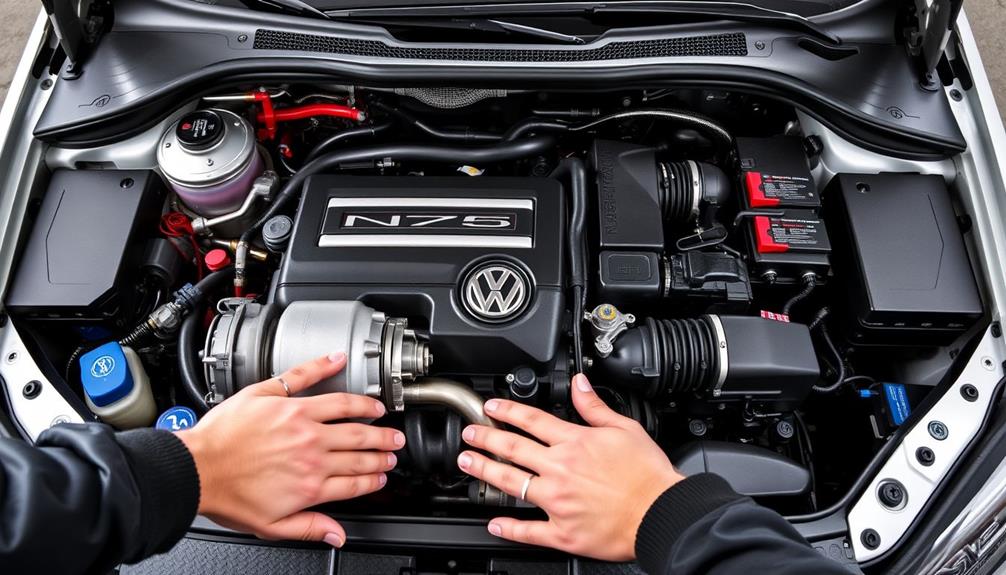
The N75 valve plays an essential role in regulating boost pressure in your Volkswagen Jetta GLI 1.8 Turbo, directly impacting your car's performance.
When it's time for a replacement, understanding the process is key to ensuring everything goes smoothly.
Let's break down how the N75 valve works and what you need to do for a successful swap.
N75 Valve Functionality Explained
Understanding the N75 valve's functionality is vital for maximizing the performance of your turbocharged VW engine. This significant component regulates boost pressure, guaranteeing your engine runs smoothly under boost conditions.
When the N75 valve operates correctly, it optimizes the relationship between the turbocharger and the engine, enhancing overall performance.
Here are three key functions of the N75 valve:
- Boost Regulation: The N75 valve controls the amount of boost pressure sent to the engine, allowing for a balance between performance and engine safety.
- Performance Improvement: Upgrading to an N75J valve can increase boost by approximately 2 lb., translating to around 25 additional horsepower at the crank.
- Smoother Driving Experience: The sophisticated design of the N75J valve helps reduce compressor surge, leading to a more enjoyable driving experience when you're under boost.
Proper installation of the N75 valve is essential. Any misalignment can cause improper boost levels, which might lead to engine performance issues.
Replacement Process Overview
How do you go about replacing the N75 valve in your Volkswagen Jetta GLI? Start by confirming the engine is cool.
First, remove the stock turbo-to-intercooler pressure tube; this gives you better access to the N75 valve. Next, disconnect the wiring harness and take off the hose clamps from the rubber lines connected to the valve.
Once you've got everything disconnected, it's time to install the new N75J valve. Make sure it's oriented correctly before reattaching the intercooler tube and wiring harness. This step is vital for maintaining peak performance.
After installing the new valve, check all connections to confirm they're secure. Proper installation is essential to avoid issues like compressor surge, which could hinder your performance gains.
ECU Tuning Benefits

Revealing the potential of your Volkswagen Jetta GLI through ECU tuning can greatly enhance your driving experience. By modifying boost, fueling, and ignition maps, you can achieve impressive horsepower gains—typically around 10 hp for every 1 PSI increase in boost pressure.
This tuning process isn't only effective but also cost-efficient, often costing around $69 and providing significant performance improvements without the need for additional hardware modifications.
Here are three key benefits of ECU tuning:
- Increased Power: With performance software like Unitronic's Stage 1 and Stage 1+, you could see gains of up to 55 hp and 102 lb-ft of torque when moving to Stage 2 with supporting mods.
- Seamless Integration: Re-flashing the ECU allows for features like map switching and valet mode, making your driving experience more versatile.
- Optimized Performance: Proper tuning guarantees a balanced fuel and air supply, enhancing engine reliability while preventing issues like running lean or excessive boost that could trigger limp mode.
With these benefits, ECU tuning is a smart step toward revealing your Jetta GLI's full potential.
Boost Management Considerations

Proper boost management is vital for maximizing the performance of your Volkswagen Jetta GLI's turbocharged engine. Improper boost levels can lead to engine damage and trigger limp mode due to the ECU's safety features. Upgrading to a high-quality N75J valve can increase boost by approximately 2 lb., translating to an additional 25 hp while improving engine smoothness.
Here's a quick overview of boost management considerations:
| Modification | Boost Impact | Performance Gain |
|---|---|---|
| N75J Valve Upgrade | +2 psi | +25 hp |
| ECU Flash | +1 psi | +10 hp |
| Manual Boost Controller | Risk of Overboost | Potential limp mode |
Flashing the ECU optimizes boost levels, air, and fuel delivery, providing significant performance upgrades. However, be cautious with Manual Boost Controllers (MBCs) as they can inadvertently trigger limp mode from overboosting. Regularly monitoring boost levels is essential to maintain the health of components like the diverter valve (DV) or blow-off valve (BOV). Confirm your boost management strategy is precise to protect your engine and enhance performance.
Intake and Airflow Improvements

When tuning your Volkswagen Jetta GLI, upgrading to a performance cold air intake can greatly boost airflow and lower intake temperatures, giving you a noticeable power increase.
Pairing this with an upgraded intake manifold will further enhance airflow and turbo response, maximizing your engine's potential.
These improvements are essential for achieving the best performance in your tuning journey.
Cold Air Intake Benefits
A cold air intake (CAI) is one of the best modifications you can make for your Volkswagen Jetta GLI, as it greatly boosts airflow to the engine. By enhancing combustion efficiency, you'll notice significant increases in horsepower and torque output.
Here are three key benefits of installing a CAI:
- Improved Airflow: CAIs are designed to increase air volume and velocity, leading to better throttle response and overall engine performance.
- Lower Intake Temperatures: By reducing heat soak from the engine bay, CAIs help keep intake air cooler, which is especially beneficial during high-demand driving conditions.
- Enhanced Sound: A performance cold air intake provides a distinctive, aggressive engine note, adding excitement to your driving experience.
With many aftermarket CAIs undergoing rigorous flow-bench and temperature testing, you can trust that these performance upgrades yield maximum gains for your Jetta GLI.
Intake Manifold Upgrades
Upgrading the intake manifold on your Volkswagen Jetta GLI can considerably enhance engine performance by improving airflow and combustion efficiency. A performance intake manifold allows for increased airflow, which means better combustion and a noticeable boost in horsepower, especially in high-power applications.
These manifolds often feature larger plenum volumes and smoother airflow paths, effectively reducing restrictions and improving throttle response.
Many aftermarket options are designed to work seamlessly with multi-port injection and nitrous systems, giving you versatility for future performance upgrades. Aluminum intake manifolds are particularly popular for MQB-based models, offering a lightweight solution that enhances overall engine efficiency and performance.
To guarantee that your upgraded intake manifold delivers maximum benefits, flow-bench testing is essential. This process optimizes airflow while reducing intake air temperatures, ultimately leading to improved engine performance.
By investing in a high-quality intake manifold, you're setting the stage for significant gains in horsepower and responsiveness, making your Jetta GLI not just faster, but also more enjoyable to drive.
Don't underestimate the impact of this critical performance upgrade on your turbocharged sedan.
Turbo and Intercooler Options
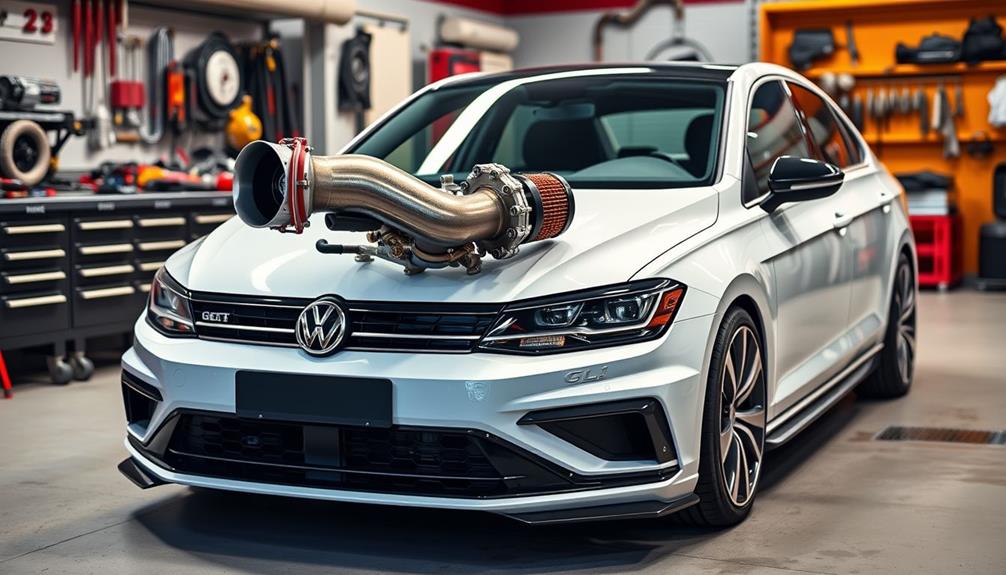
Boost your Volkswagen Jetta GLI's performance with effective turbo and intercooler upgrades. By investing in the right components, you can greatly enhance your car's power and efficiency. Here are some options to take into account:
- Upgrade to a Bigger Turbo: A turbo like the K04 can deliver impressive power gains while maintaining stock-like spool characteristics. This means you get a reliable performance boost without sacrificing drivability.
- Install a Front Mount Intercooler Kit: Managing increased air temperatures is essential, especially in high-performance applications. A quality intercooler kit prevents heat soak, ensuring consistent power output and lower charge air temperatures.
- Explore Aftermarket Turbo Kits: Kits like the GT28RS are specifically designed for the 1.8T engine, offering direct fitment and all necessary components for a seamless installation.
Coupled with the right software tuning, these enhancements maximize your vehicle's performance.
Electrical Optimization Techniques
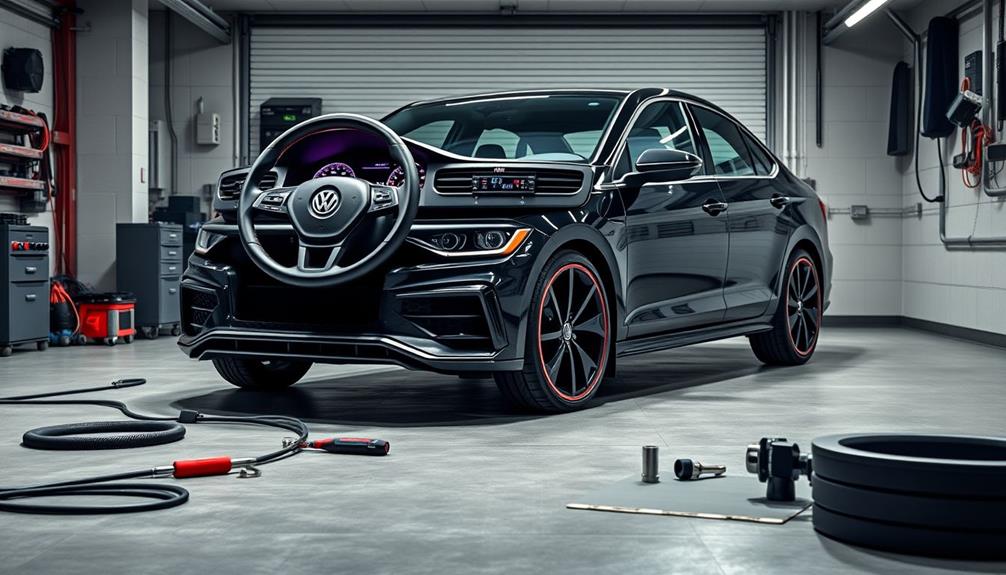
When it comes to maximizing your Volkswagen Jetta GLI's performance, electrical optimization techniques play an important role. Upgrading to APR performance coil packs guarantees consistent spark delivery under high-boost conditions, which reduces the risk of engine misfires and enhances overall engine performance.
You'll also want to take into account software tuning; it's essential for reaping the benefits of your performance upgrades. By optimizing engine parameters like boost levels, fuel maps, and ignition timing, you can achieve improved power output.
For significant efficiency gains, off-the-shelf tuning solutions from brands like COBB and Integrated Engineering work wonders when paired with intake and exhaust upgrades.
Don't overlook regular maintenance of your electrical components, such as the Coolant Temp Sensor and Fuel Pressure Regulator. Keeping these in top shape is crucial for peak engine performance and preventing larger issues down the line.
Lastly, upgrading your vehicle's ECU through re-flashing allows for real-time adjustments, enhancing performance while guaranteeing compatibility with your existing modifications. This upgrade also provides useful features like valet mode, which can be handy in varied driving conditions.
Suspension and Handling Enhancements

To truly release the potential of your Volkswagen Jetta GLI, suspension and handling enhancements are essential. Upgrading these components not only improves ride quality but also transforms your driving experience.
Here are three key upgrades to evaluate:
- Performance Coilovers: These allow for full adjustability in ride height and damping settings. You'll notice a significant boost in handling and overall ride quality.
- Aftermarket Sway Bars: By reducing understeer and enhancing grip during sharp turns, these sway bars can drastically improve your car's handling dynamics. You'll feel the difference on those twisty roads.
- Strut Braces: Installing performance strut braces stiffens the chassis, providing better steering feedback. This minimizes flex during cornering, leading to improved handling and a more connected feel with the road.
Additionally, contemplate lowering springs to reduce your vehicle's center of gravity, which enhances cornering stability and cuts down on body roll.
Maintenance for Performance Upgrades
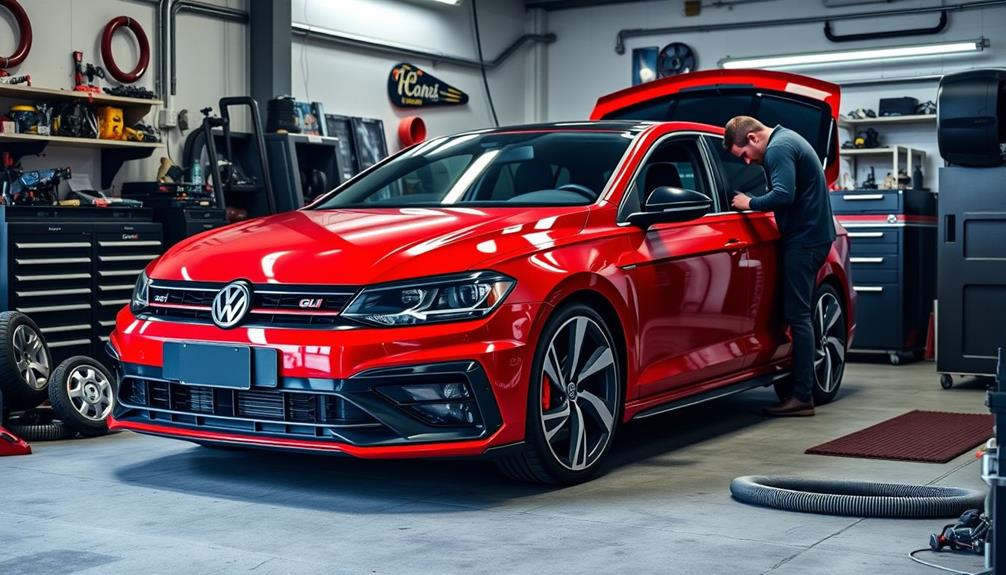
Proper maintenance is essential for getting the most out of your performance upgrades on a Volkswagen Jetta GLI. Regularly check critical components like the Coolant Temp Sensor, Intake Manifold Gasket, and Oil Pan Gasket Sealer to prevent performance issues. These parts play an important role in ensuring your engine runs smoothly, especially under high-boost conditions.
Upgrading to performance coil packs is also a smart move. They deliver consistent spark, essential for maximizing power and avoiding misfires. Additionally, implementing a catch can breather system helps prevent oil vapor blow-by, keeping your intake manifold clear and maintaining engine efficiency.
Don't overlook the wastegate and diverter valves (DV). Monitoring these components is crucial to avoid boost leaks, which can severely impact your turbocharged engine's performance and response.
Regular inspections of the intercooler and associated piping are equally important; leaks or blockages here can lead to inefficiencies and decreased power output during spirited driving.
Frequently Asked Questions
How to Increase Power on 1.8 T?
To increase power on your 1.8T, consider upgrading to a performance cold air intake, flashing the ECU, installing a high-flow downpipe, and adding a larger front mount intercooler for better airflow and boost management.
How Much HP Can a Jetta GLI Make?
If you're curious about horsepower, a Jetta GLI can generate gains galore! With proper tuning and mods, you could see power soar from 180 to around 300 horsepower, depending on your upgrades and commitment.
How to Increase Horsepower in a Jetta?
To increase horsepower in your Jetta, consider upgrading the ECU with performance software, installing a cold air intake, replacing the exhaust system, adding a larger turbocharger, and incorporating an upgraded intercooler for better efficiency.
How Much Horsepower Does a 1.8 Turbo Volkswagen Jetta Have?
If you've got a 1.8 Turbo Jetta, you're looking at around 180 horsepower. With some tuning and upgrades, like a larger turbo, you could easily push that figure to 250 or more.
Conclusion
To sum up, tuning your Volkswagen Jetta GLI 1.8 Turbo can greatly elevate your driving experience. With the right performance upgrades, you could see power gains of up to 30% or more, transforming your sedan into a thrilling ride. Remember, balancing performance with reliability is key, so keep up with maintenance. By investing in quality modifications, you're not just enhancing speed; you're also increasing your vehicle's overall enjoyment and responsiveness on the road.





